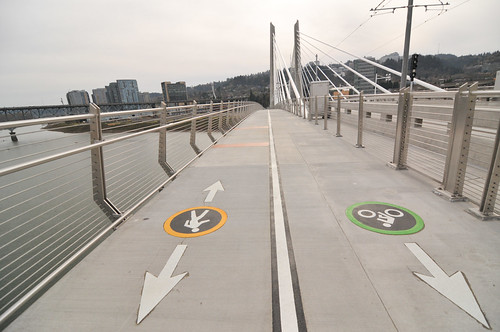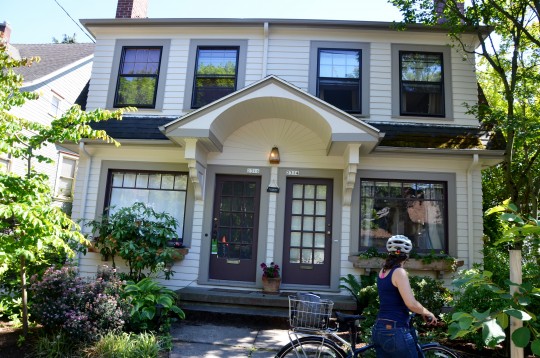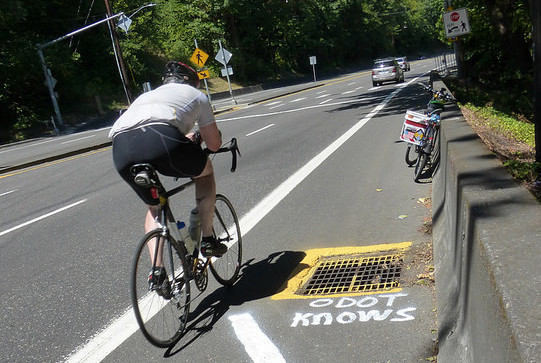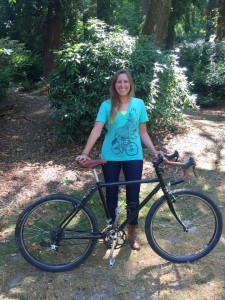“My heart is so full of love for this city, and for everyone far and wide who somehow heard my story and took a moment to care and empathize.”
— Megan Holcomb upon the recovery of her stolen bike back in July.
It’s been the best of times; it’s been the worst of times.
If 2014 was the year when Portland first came to terms in a meaningful way with the fact that it’s no longer the nation’s undisputed biking capital, 2015 has been the year when Portlanders responded. It took a year of tireless work by local volunteers and pros, working alone and in institutions new and old, but it culminated in a series of major victories in late summer and fall:
- a citywide policy declaring all traffic deaths to be a partly public responsibility
- an innovative new bike-sharing system
- a new set of standards for neighborhood greenways
- a pilot effort to institutionalize Better-Block style on-street experiments in the city’s planning process
- a plausible plan for new mountain biking trails within city limits
There’s been lots of bad news too, from horrific collisions to frustrating decisions, reminding us of how much work remains.
As always, most of the bike stories that captured Portlanders’ imaginations were the ones about individuals — people whose stories fit into the city’s best and worst trends. Based on our traffic logs, here are the stories of the year that caught the most curious clicks, starting with #1:
Jan. 13: “This $50 device could change bike planning forever”

(Photo: M.Andersen/BikePortland)
In the first week of 2015, we came across a city document about a project code-named “Honey Bee Bike Counters” and wondered what was up. A quick tip from a city staffer connected us with William Henderson, whose local startup Knock Software was at work on two projects: a cheap box that could automatically count people passing on foot or bike and a mobile app that could easily track the stress of people’s biking routes.
Starting with the question “Do bikes count?”, our post focused on the first project. It’s the second one, now called Ride Report, that’s coming to market first. But Henderson’s plans for the counter remain alive, much to the enthusiasm of transportation professionals who (eager for this project to work) shared our post widely in their networks.
March 17: “Touring Tilikum: My first walk across the new bridge”

(Photo by J. Maus/BikePortland)
Our new car-free bridge across the Willamette is Portland’s signature transportation accomplishment of the year, and the popularity of this post in March was an early sign of the stunning public excitement about Tilikum Crossing when it finally opened in September.
Despite the shortcomings of Tilikum and its immediate surroundings (and the fact that it could never live up to sky-high expectations) it’s a major accomplishment that will feel, 10 years from now, like a no-brainer that the city couldn’t live without.
April 6: “Hit-and-run bike rider leaves one duck dead”
Certainly our most infamous post of the year, this emailed account of an avian bike fatality on the path near Bethany Lake in Washington County was notable partly for the sad story it told but mostly for the epic comment thread that sprouted from it, which included a not particularly gracious apology from the man who killed the bird.
May 28: “Rider in Gladstone fatality graduated from Reed College last week”
A post May 27th about a man killed by a truck at noon in a bike box on a major bikeway in the middle of the city’s bikeable grid startled and angered many Portlanders.
The follow-up the next day, that the man had managed Reed College’s bike co-op and had just graduated the previous week, deepened the tragedy.
Four months after Mark Angeles’ death, the co-op renamed itself in his honor. Angeles’s legacy also continues in the city’s actions following his death: its new Vision Zero and neighborhood greenway policies, both of which commit the city to proactive, empirical measures to improve its streets systematically rather than just ticking projects off wishlists.
Aug. 5: “After man adds warning paint to sunken grate, state roads agency calls it vandalism”
Before moving to China this month for a job teaching English, longtime local biking advocate Jim Parsons left the Portland area with one last priceless story.
Seven years after his first complaint to the state Department of Transportation about a pair of sunken grates on Southwest Barbur Boulevard, Parsons got fed up by the lack of action, spray-painted them in yellow warning paint with the words “ODOT KNOWS,” posted the photos online and sent an email to BikePortland.
Even that guerrilla action might not have been a big story if not for ODOT’s official response: an email to Parsons accusing him of vandalism and scolding him for forcing the agency to send a crew to the site to … remove his paint.
That response was too much for BikePortland readers, several of whom have turned “ODOT KNOWS” into a sort of recurring meme. Fortunately, the TV coverage that resulted was too much for ODOT, which fixed the grates a week later and said in an official statement that it welcomes warnings from gadflies like Parsons.
May 10: “Sunday morning collision at 26th and Powell severs leg of man on bike”

(Photo courtesy Kenji Sugahara)
Mother’s Day was darkened this year by the terrible news that Alistair Corkett, 22, had nearly been killed in a collision with a truck turning left in front of him as he headed straight south on 26th at Powell. The Bike Gallery employee and regular bike racer lost a leg on the scene.
Crockett survived and is likely to keep moving with the help of prosthetics. Though the collision (like that of Angeles) didn’t result in any criminal charge, it did trigger a broad, continuing conversation about the perpetual safety problems on the ODOT-controlled Powell Boulevard.
Advertisement
June 19: “Why are these 11 buildings illegal in most of Portland?”

(Photo: M.Andersen/BikePortland)
Inspired by a PedalPalooza ride that sent participants on a search for the “missing middle” of Portland’s housing market — duplexes, four-plexes, townhomes and low-rise garden apartments — we shared photos of 11 buildings that went up before the 1959 zoning reform that mandated separated yards and driveways for new homes on most of Portland’s residential land. As we saw, many of the small pre-1959 homes seem to fit perfectly into their blocks, and in fact are some of the only units that remain somewhat affordable in some of the city’s most bikeable neighborhoods.
The city is currently circulating a public survey asking residents whether it should re-legalize things like internal home divisions in an effort to ease Portland’s housing shortage, or whether it should take the opposite tack and crack down on creating new homes.
July 28: “Security video helps police nab prolific bike thief (yet again)”

(Photo: Portland Police Bureau)
The last three stories in our top 10 all concern one of the biggest bike stories of the year: the fight against theft. First up was a July report about the arrest of Johnathan Marcel Dubouis, a man who’s been arrested repeatedly for bike theft. Dubouis allegedly decided it was a good idea, in an interview with police, to blame bike owners for using cable locks.
Dubouis’ latest arrest was possible because he seemed to have been caught on a security camera stealing a bike outside the tony Multnomah Athletic Club. It was also a milestone for the Portland Police Bureau’s two-cop anti-bike-theft team, which is looking for any tools available that can slice the cables of the city’s underground economy of stolen bikes.
Dec. 22: “Portland’s most wanted bike thief gets unprecedented prison sentence”
Leroy Parsons showed up as a minor character in the Dubouis story: a cautionary tale that even the worst repeat offenders are typically out of jail in a matter of weeks at the most. But that changed last week, when Parsons (described as a “kingpin” of bike theft by Portland police) received a sentence that included 18 months in prison, mandatory drug treatment and an unusual deal that will forbid him from using any bikes unless he can prove to police that he bought them legitimately.
It may be hard to pity a man who has confessed on camera that he steals bikes, but (like Dubouis) Parsons is also an illustration of the sad links between drug addiction, mental health, homelessness and property crime.
July 24: “Megan Holcomb has recovered her stolen bike!”
Sometimes, the good team wins.
Days after she rode across the country from Washington D.C. to Portland, the Surly Long Haul Trucker that Megan Holcomb had made the journey on was stolen. Because she knew almost no one in Portland, she didn’t have much hope, but she created a Facebook post with a description and four photos of the bike. The post went viral and two days later she had gotten it back with the help of Andrea Gellatly, who Holcomb dubbed “Portland’s new hero.”
“My heart is so full of love for this city, and for everyone far and wide who somehow heard my story and took a moment to care and empathize,” she wrote. “Not because it brought the bike back, but because it brought us all together. This city is definitely weird but dang do you all have heart!!!”
We couldn’t ask for a better epitaph for 2015. Here’s to more weirdly successful cooperations for the greater good in the year to come, Portland.
If you appreciate our work and want to see it thrive in 2016 and beyond, please subscribe today and join the 195 other readers who make BikePortland possible. We need your help now more than ever.
— Michael Andersen, (503) 333-7824 – michael@bikeportland.org






